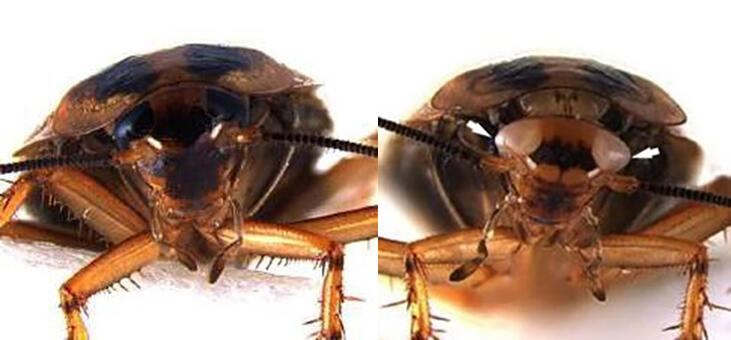Professor Takaaki Daimon and graduate student Yu Shirai of the Graduate School of Agriculture, Kyoto University, in collaboration with the Institute of Evolutionary Biology in Spain, announced that they have developed the direct parental CRISPR (DIPA-CRISPR) method, which enables genome editing in insects through a simple operation. By simply injecting CRISPR/Cas9 into adult females a generation of genome-edited individuals can be obtained. The research group also succeeded in editing the genome of cockroaches for the first time in the world. In principle, their finding should be applicable to all insect species. The results are expected to lead to expanded use of insects for research and industrial applications as model animals. The results were published in the May 16 issue of the international scientific journal Cell Reports Methods.

An eye color gene cinnabar is disrupted by DIPA-CRISPR.
Image credit: Yu Shirai (Kyoto University)
There are high expectations for the use of insects for not just agricultural purposes, but also as model animals for research and industrial applications in the future. One issue is that insect genome editing has typically required the injection of genome editing tools such as CRISPR/Cas9 into eggs (early embryos), which requires advanced techniques and is almost impossible for some insect species. For example, cockroaches lay eggs inside their bodies and wrap them in ootheca before releasing them, but if the eggs are taken from the ootheca, the hatchability rate declines, so it is necessary to inject the eggs from outside of the ootheca, which is difficult given that it is hard. This was also difficult to do with parasitic insects and insects that lay their eggs in plants and other locations. Moreover, these operations required expensive equipment, a specific experimental setup for each species, and highly skilled laboratory personnel.
In 2018, a U.S. research group reported that genome editing could be performed by injecting adult female mosquitoes with CRISPR/Cas9, but this method has not been generalized across species because it required the independent production of modified Cas9 proteins and was less efficient than conventional methods.
From this background, the research group examined ways to simplify and improve the efficiency of the method by injecting adult insects. It has long been known during yolk formation oocytes take up large amounts of vitellogenin (yolk protein) in body fluids via endocytosis. So the research group first sought to knock out the ommochrome pigment gene, the pigment of the compound eye, primarily by injecting a commercially available genome editing tool (CRISPR/Cas9) when adult female cockroaches are in the yolk formation stage, which has been thought to have been impossible for genome editing. A study of larvae hatched from eggs produced by these females revealed the presence of genome-edited individuals, albeit at a low frequency of 2%.
They subsequently examined the timing of the injections and other conditions to study changes in editing efficiency. After identifying the optimal conditions and performing injections, the research group confirmed that 55 of 244 larvae (22.5%) had the mutant allele and that genome editing was more efficient than previously possible. Many of the genome-edited individuals developed a mosaic mutation that caused some compound eyes to become white in color, but some individuals appeared to have both eyes mutated to white. By crossing genome-edited individuals, they also succeeded in establishing the world's first gene knockout cockroach strain.
Analysis performed while studying the process of optimal conditions found that the optimal timing of injection coincided with the timing of vitellogenin uptake. The research group also found Cas9 protein injected into adult insects to be taken up by oocytes along with vitellogenin.
To further investigate the possibility of applying this technology to other insects, the group conducted an experiment with cockroaches and the phylogenetically distant Tribolium castaneum beetle and found that they were able to edit the genome of 28 out of 54 larvae (51.9%) with high efficiency. From this they confirmed that genome editing is possible in other insect species. They also confirmed that knock-in is possible, which is more advanced than knock-out. As insects have open circulatory systems and their internal organs exist in body fluids, the group felt that injections could be done anywhere. However, each species of insect has a different yolk-forming period (several days), so this basic information needs to be analyzed going forward.
The research group reviewed commercially available genome editing tools from four companies and confirmed all to be capable of highly efficient genome editing. Until now, genome editing of insects has required equipment costing about 3,000,000 yen, but with this method, genome editing can be performed with equipment that is much cheaper, costing around only 300,000 yen. Since the injections can be done anywhere and training can be completed in less than half an hour, this method can be used in laboratories of any size and in any country, this is expected to make a significant contribution toward advancing research.
One concern is that in countries that do not have regulations on genome editing comparable to those that exist in Japan, any strains produced could leak into the natural world due of the ease with which the process can be done. "Since the uptake of vitellogenins during yolk formation is common in arthropods and myriapods such as shrimp and crabs, we expect that it can be applied to all oviparous animals," says Dr. Daimon. "We also reported in 2018 that we initially tried to do this with our own generated Cas9 protein, and it did not work, but it did work with a commercial product. In the future, we hope to solve the mystery of why commercial products worked but our own generated Cas9 protein did not. Once we know this information, we believe we can improve our technique for insects in the future."
This article has been translated by JST with permission from The Science News Ltd.(https://sci-news.co.jp/). Unauthorized reproduction of the article and photographs is prohibited.




